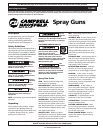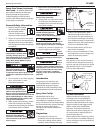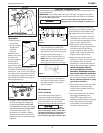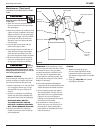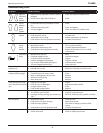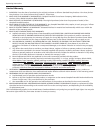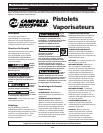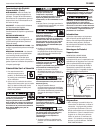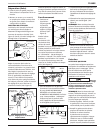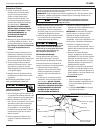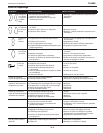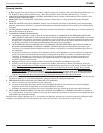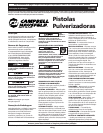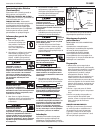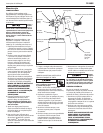
3
Operation
1. Begin spraying.
Always keep
the gun at right
angles to the
work (See
Figure 4).
Keep the nozzle
about 6 to 9 inches
from the work
surface throughout
the stroke and
always keep the
gun in motion while
spraying. Stopping gun movement in
mid-stroke will cause a build up of paint
and result in “runs.” Do not “fan” the gun
from side to side while painting. This will
cause a build-up of paint in the center of
the stroke and an insufficient coating at
each end (See Figure 5).
2. “Trigger” the gun properly. Start
the gun moving at the beginning
of the stroke BEFORE SQUEEZING
THE TRIGGER and release the trigger
BEFORE STOPPING GUN MOVEMENT
at the end of the stroke. This
procedure will “feather” (blend)
each stroke with the next without
showing overlap or unevenness (See
Figure 6).
3. The amount of paint being applied
can be varied by the speed of the
stroke, distance from the surface and
adjustment of the fluid control knob.
4. Overlap strokes just enough to
obtain an even coat (See Figure 7).
NOTE: Two thin coats of paint will
yield better results and have less
chance of runs than one heavy layer.
5. Use a piece of cardboard as a shield
to catch overspray at the edges of
the work to protect other surfaces.
Use masking tape to cover other
areas if needed.
Maintenance
DAILY CLEAN-UP
Local codes may require specific
cleaning methods and equipment.
Follow local codes and manufacturer’s
recommendations for the use and
disposal of spray materials and solvent.
Clean
spray
gun immediately after use. Paint and
other material dry quickly in the small
passages rendering gun useless due to
the difficulty of removing hardened
paint from the passages inside the gun.
NOTE: In the instructions below, the
use of the word “solvent” refers to the
specific solvent for the material used
(eg: lacquer thinner for lacquer, etc ).
1. Spray guns with canister—Remove
and empty the canister; then rinse
with a solvent recommended for the
paint or other material used.
2. Refill canister with clean solvent
and attach to the gun. Spray solvent
through the gun while shaking
the gun vigorously. Wipe the gun
exterior with a solvent soaked rag.
Repeat until the gun is clean.
3. Remove the air cap and soak in
solvent until clean. Use a small brush
for stubborn stains if necessary.
Toothpicks or small brushes may be
used to clean air passages; however,
NEVER USE METAL OBJECTS
TO CLEAN PRECISELY DRILLED
PASSAGES. DAMAGED PASSAGES
WILL CAUSE IMPROPER SPRAYING.
4. Clean gaskets with a solvent soaked
rag. To prevent equipment damage,
Do not immerse gaskets or spray
gun body in solvents.
5. After using water to clean out water
based paints or materials, spray
mineral spirits through the gun to
prevent corrosion.
6. Use a non-silicone oil on all moving
parts when reassembling. Use
Vaseline
®
or light grease on all
threaded connections prior to storage.
7. Clean and flush gun thoroughly
to neutralize any contaminants
corrosive to the spray gun.
WATER/OIL IN COMPRESSED AIR
All compressor pumps discharge some condensed water, oil or contaminates with
the compressed air.
IMPORTANT: This condensation will cause “fish eyes” to appear in the paint
job. Install appropriate water/oil removal equipment and controls as necessary
for the intended application.
Failure to install appropriate water/oil removal
equipment may result in damage to machinery or
workpiece.
Figure 3 - Air Adjustment on Spray Gun
Increase
Air Flow
Decrease
Air Flow
Air Control
Knob
Operating Instructions TL2402
www.chpower.com
6 - 9
inches
Figure 4
Thin coat Thin coat
Heavy coat
Figure 5
INCORRECT
6 - 9 inches
Pull
Trigger
Start
Stroke
Release
Trigger
End
Stroke
Figure 6
Figure 7



